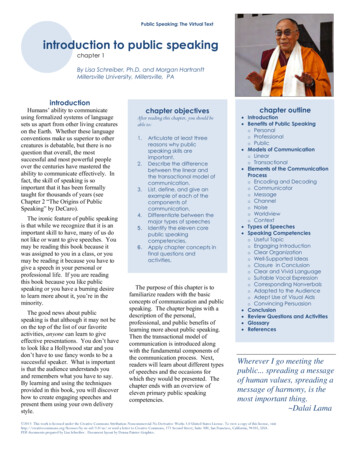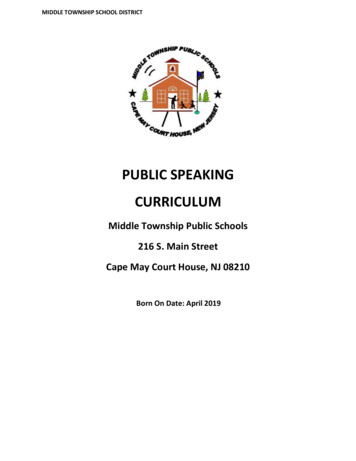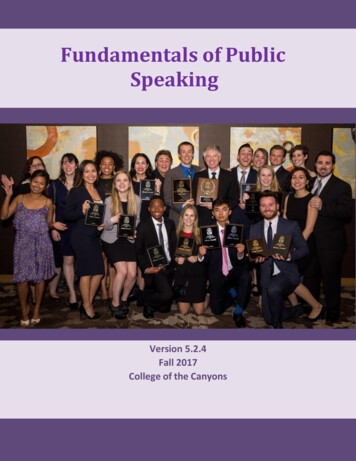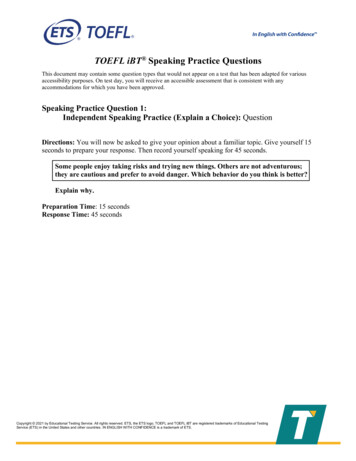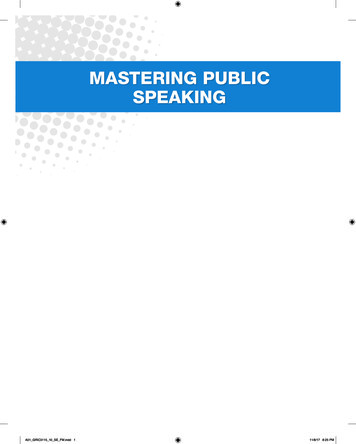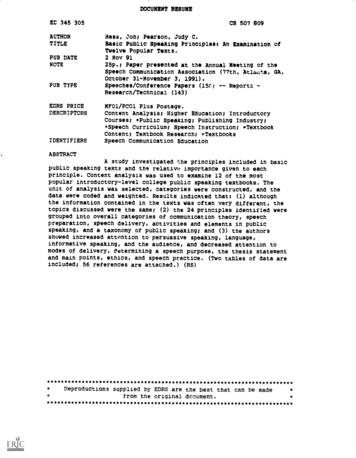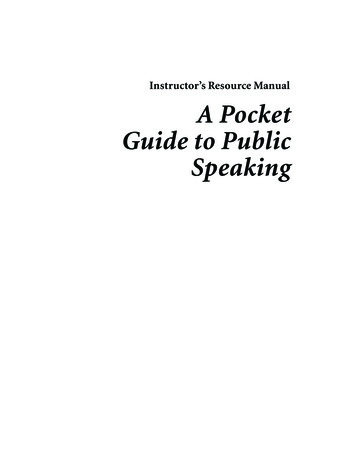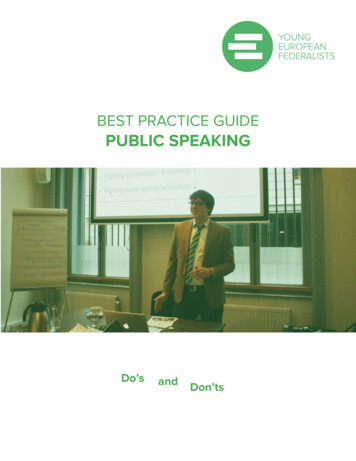
Transcription
BEST PRACTICE GUIDEPUBLIC SPEAKINGDo’sandDon’ts
IntroductionThe aim of this paper is to give you a brief overview of the main things to think about whenit comes to public speaking. It includes the definition borrowed from Wikipedia, a fewuseful tips, an illustration of the different type of presentations, and a 10 point list of howone can ruin a presentation. Despite being a seasoned public speaker myself I haveto admit that some of the simple stepsdiscussed hereinafter is something thatI should adhere to more diligently myselfand, more importantly should help makepublic speaking better experience– for both you and your audienceDefinitionPublic speaking is the process and act ofspeaking or giving a lecture to a groupof people in a structured, deliberatemanner intended to inform, influence, or entertain a listening audience. Public speakingis commonly understood as face-to-face speaking between individuals and an audiencefor the purpose of communication. It is closely allied to “presenting”, although the latteris more often associated with commercial activity. Most of the time, public speaking is topersuade the audience (source Wikipedia).Presentation formatBefore you start planning your presentation, find out from the organizers how much timeyou have and what format they envision for your talk.Will you be part of a panel or will you be speaking alone?Will you be in a regular session or are you the dinner speaker?Do you have 15 minutes or an hour?Do they prefer to leave time for questions? If yes, does that come out of the allocated time you have been quoted?It is important to know what is expected of you so you can be well prepared and not haveto scramble last minute to readjust your talk due to unanticipated logistics.
Know your audienceGet information about who will be attending your presentation. Are all participants experts at the topic or will there be novices present? Is there a mixed group of people representing different backgrounds or is everyone on the same page regarding technicalities?Depending on the audience, you will have to spend some time giving varying degrees ofbackground on the material and explaining certain concepts.A word of caution: don’t overdo it either. Don’t get cought up in details and technicalities.
Frame your storyThere’s no way you can give a good talk unless you have something worth talking about.Conceptualizing and framing what you want to say is the most vital part of preparation.We all know that stories are a powerful tool for communication and therefore, metaphorswhich abound the narrative structures work best to engage people.Approach 1: Consider it as planning a journey where the biggest decisions are where tostart and where to end. To find the right place to start, consider what people in the audience already know about your subject – and how much they care about it. If you assumethey have more knowledge or interest than they in fact do, or if you start using jargon orget too technical, you’ll lose them. The most engaging speakers do a superb job of veryquickly introducing the topic, explaining why they care so deeply about it, and convincingthe audience members that they should, too.Approach 2: Have a narrative structure that loosely follows a detective story. The speakerstarts out by presenting a problem and then describes the search for a solution. There’san “aha” moment, and the audience’s perspective shifts in a meaningful way.As a general rule, people are not very interested in talks about organizations or institutions. Ideas and stories fascinate us; organizations bore us – they’re much harder to relateto.
The take-away messageIf someone who missed your talk were to ask an audience member in the elevator to sumit up, what would you like that person to say? Focus on that message. Start out with thissummary statement in mind and build your presentation around it.Plan your deliveryThere are three main ways to deliver a speech. You can read it directly off a script. You candevelop a set of bullet points that map out what you’re going to say in each section ratherthan scripting the whole thing word for word. Or you can memorize your speech, whichentails rehearsing it to the point where you internalize every word. Don't do number oneas reading a speech is the most boring thing for everyone! For me bullet points proved tobe the most reasonable system as remembering the entire speech by heart might provetoo stressful or time-consuming. Don't write out the material word-by-word and don't planon reading text even if you do have it all written down. Having the text written out andparts of it memorized will constrain you. Memorize the structure of the talk and the outline,but not every word.TimingPeople rarely want to listen to someone for longer than the allotted time. Few people aresuch amazing speakers that an audience can't get enough of them. Do not assume youare one of those few. Wrap up your talk on time. To achieve this goal, ask someone to giveyou time cues by indicating when you have five minutes left, two minutes and when youhave run out of time. Once you get the last notice, you should stop talking.
10WAYS TO RUIN APRESENTATIONTake a really long time to explainwhat your talk is about.Speak slowly and dramatically.Why talk when you can orate?Make sure you subtly let everyoneknow how important you are.Refer to your book repeatedly.Even better, quote yourself from it.Cram your slides with numerous textbullet points and multiple fonts.Use lots of unexplained technicaljargon to make yourself sound smart.Speak at great length about the history of yourorganization and its glorious achievements.Don’t bother rehearsing to checkhow long your talk is running.Sound as if you’re recitingyour talk from memory.Never, ever make eye contactwith anyone in the audience
FlexibilityOrganize your talk and know it well enough to have the flexibility to skip certain parts orexpand on others depending on the circumstances. For example, if you do add a last-minute introduction, be flexible to skip a part of the prepared content.Practice makes perfectPractice the presentation a few times: more if you have less experience, less if you are amore seasoned public speaker. It can be especially helpful to give the talk to someonewho is not in your field and is not intimately familiar with the material. This is helpful inseeing whether you have made the talk too narrowly focused or overly technical. Such apractice session does not have to involve the entire talk, it can consist of telling someoneabout your presentation outline.ConclusionFinish your speech by one or several of the following (depending on the circumstancesin which you are making your delivery): a) thank the organizers and everyone involved inthe event, particularly the volunteers by acknowledging their contribution; b) repeat yourmain message one last time, especially if you are aiming to convince or influence an audience who are decision-makers or similar; c) provide some contact information, includingan email address and Web site when applicable; d) mention that you welcome people’sfeedback and they should feel free to ask you questions either after the session or bysending you an email.
CLOSING WORDSAs hard as it may be to give a great presentation, speech or talk, it's really easy to blow it.In this short best practice guide you will find some common mistakes any speaker shouldavoid by all means and a lot of tip’s on how to make your presentation professional.Good luck!Peter MatjašičPresidentEuropean Youth ForumLayout: Espen Berg-Larsen
Public speaking is the process and act of speaking or giving a lecture to a group of people in a structured, deliberate manner intended to inform, influence, or entertain a listening audience. Public speaking is commonly understood as face-to-face speaking between indi



